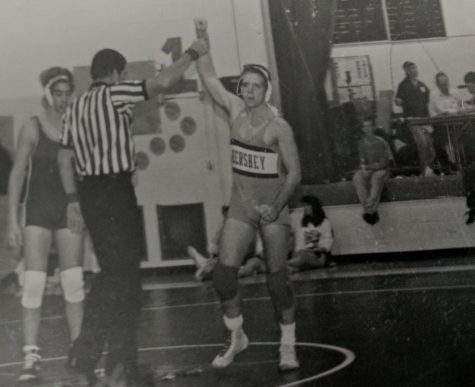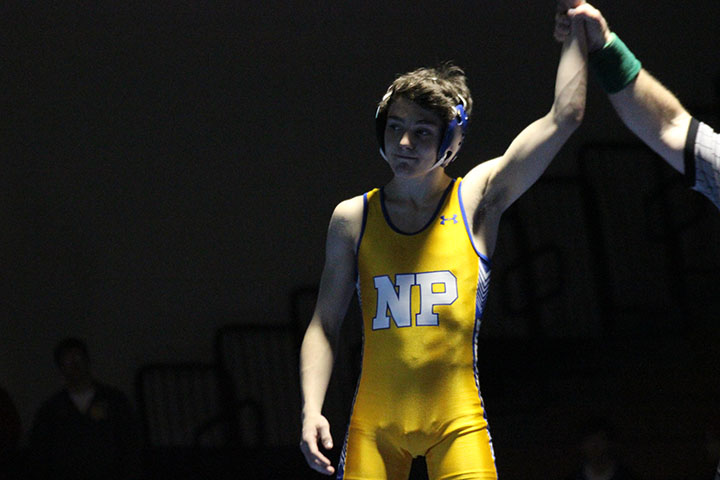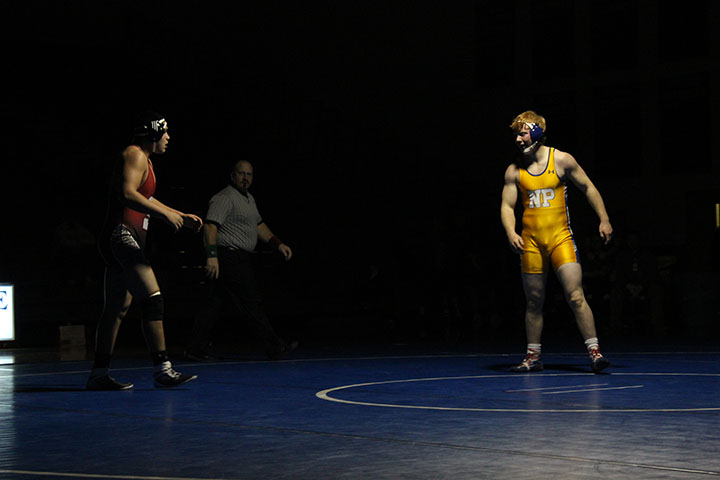Wrestling: past vs. present
Jayson Scott smiles with pride after winning his match against Scottsbluff.
Wrestlers have been known to use extreme measures for weight loss. Twenty years ago, there weren’t any regulations to keep wrestlers from using drastic methods to lose weight.
Arttie Parker,North Platte High s School TIES teacher, wrestled varsity at Hershey in the 1980’s and later wrestled at University of Nebraska Kearney in the 1990’s. Parker was exposed to the extreme methods that were used in the past. Parker never had to cut weight, but he has seen kids that used sweatsuits made of rubber when they worked out or when they slept. They would go two or three days without eating and spit in bottles all day. If it came down to it, they would shave all of the hair off of their body. “There was a kid in high school that should have wrestled at 160 pounds and was at 135. I saw him pass out and fall straight into his salad at lunch,” Parker said. Even though some athletes used these methods, Parker was never encouraged by his coaches. It was all driven by the personal viewpoints of wrestlers.

“No coach of mine ever told me I had to cut weight or do anything drastic,” Arttie Parker said.
In 1997, three different wrestlers at the collegiate level died within six weeks from excessive weight loss workouts. These deaths were not taken lightly by the NCAA. In 1999, the NCAA put in a program to mandate the way wrestlers are allowed to lose weight. Now, wrestlers have to pass a hydration test, and body fat percentage test before they can compete. Wrestlers are then monitored to keep them at a healthy weight. They can only lose 1.5% of their body weight per week, and cannot go below 7% body fat. These regulations were not put into effect for high schoolers until 2005 by the National High School Federation. Great Plains Health athletic trainer Destri Milsap, performs these tests. “We are here for the team and if anyone needs any extra help we have a health specialist at the hospital they can talk to,” Milsap said.
The North Platte High School wrestling program strictly follows these rules. “They have stipulations to make wresting safer than it has ever been,” head wrestling coach Dale Hall said. “The [National Wrestlers Coach Association] is a web based program that trains countless coaches how to keep their athletes healthy,” said Mike Moyer executive director of NWCA. The program gives a minimum weight division based on the natural weight of the athlete, and a safe weight loss program with meal plans.
However, it’s not just about cutting weight to Hall. “If you look at someone who isn’t cutting, like junior Braiden Ruffin, it shows that you don’t have to cut weight to be good. You have to get to the weight room, learn the technique, and become a better wrestler,” said Hall. “People think that wrestlers don’t eat or drink but that’s not how you cut weight. It really is changing how your portions are and working out harder,” Ruffin said.
“You don’t know how cutting weight is until you do it. So you have to know how to do it right so you don’t kill yourself,” Ruffin said. Junior Jayson Scott, weighs 118 pounds and is trying to cut to 113. “I just eat pretty clean, work out hard at practice, and do extra workouts with sweats on to cut weight,” Scott said. Junior Alec Manzano naturally weighs 145 pounds and wants to drop to 138 pounds. “I wear heavy stuff during practice and keep my diet pretty boring. No carbs and a lot of fruits,” Manzano said.
Rules and mentalities have been affected by the deaths of wrestlers of the past and have changed the way wrestling is treated. “If your kids are more interested in cutting weight than becoming a good wrestler, it’s not what we are looking for,” Hall said.

Bryce Lee (‘18)
Co-Editor in chief
What's up North Platte High. It's your co-editor in chief Bryce Lee. You have probably heard me yelling during the...


